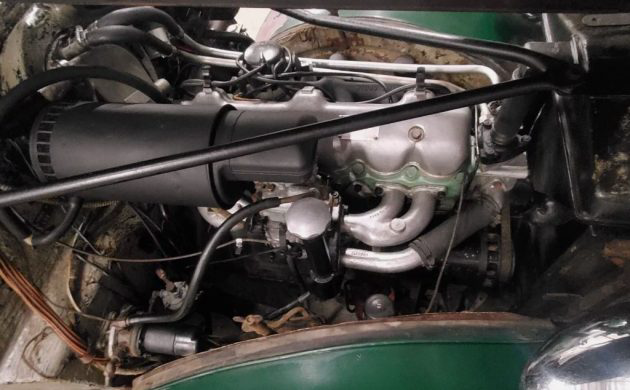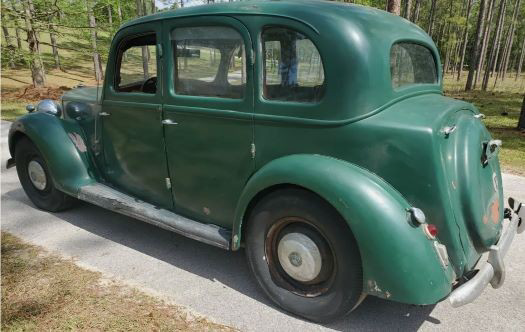Rover’s story began like many a British maker – crafting bicycles and motorcycles starting in 1878. The company’s name was associated with “wandering”, and it chose a Viking longship as its emblem, symbolizing exploration. When the automobile market erupted at the turn of the century, Rover pivoted as well, introducing its Eight – a tiny open two-seater with an 8-hp single-cylinder engine. WWI did the company no favors. Financial recovery was ushered in by a move upmarket. Despite forays into jet engines and gas turbine engines for cars, Rover buckled down after WWII, introducing the P3 in 1948. Equipped with an engine in development since the 1930s and sheet metal barely different from the pre-war P2, the P3 was nonetheless aimed at the well-off buyer. Today’s example has been in one man’s ownership for over forty years; it was parked near its current home in Williston, Florida twenty years ago and hasn’t run since.
Despite the long slumber, the underhood view is pretty spiffy and the engine is said to turn by hand. The P3 came in two iterations – the Sixty and the Seventy-Five. This example is the Seventy-Five, sporting a 2.1-liter six-cylinder F-head engine equipped with a single down-draught Solex. Output is about 72 hp. The engine is coupled with a four-speed manual gearbox with a unique freewheeling feature. The freewheel saved gas and made gear changes less challenging. Top speed is about 75 mph. Underneath is independent front suspension and an anti-roll bar; brakes are hydraulic up front and mechanical behind. Speaking of underneath, high-quality storage helped keep this one dry and relatively free of serious rust, though the buyer will certainly be replacing the muffler.
The excellent catalog of photos in this listing made it difficult to choose just a couple of interior views. This shot displays the individual front seats (upholstered in leather), the banjo steering wheel, wood dash, and carpet. Unusual for the day, the Rover P3 has a sunroof. The doors are rear-hinged; body styles included the six-light saloon and the four-light sport saloon – “light” referring to the windows down each side. This example is a six-light saloon.
Our comments on Rover cannot be complete without mentioning the company’s most famous model – the Land Rover. Also arriving in 1948, the Land Rover utilized many of the same parts from other Rover cars, but most importantly, its differential (early or late) can be swapped into the P3 for more relaxed cruising on our long highways. In factory form, even the peppy Seventy-Five is best suited to back roads. Recommissioning any car can be a fun challenge; this one can be found here on eBay with an asking price of $8500 or best offer. Anyone up for an early British luxury saloon?






This is so cool. I’ve said before, it’s as if the British, or all of Europe, was a decade behind in styling from ours. The ’61 Anglia clearly had our 50s overtones, and this, for a ’48, sure looks like 30s to me. I read not a scrappy car in the least, and don’t let the 30s styling fool you. I read, this car does 0-60 in 33.3 seconds, does the 1/4 mile in a blistering 24.2 seconds @55 mph. Top speed of 75 mph, where I’d imagine the “75” comes from. Okay, not exactly John Force, who was released from the hospital, BTW, but certainly adequate for anything in England after the war. From what I read, this car was a delight to drive. I can only imagine there aren’t many LHD ones.
75 is the bhp.
…..partly agree re the slow restyling but there were a few-the Ford Mk1/2 Consul/Zephyr/Zodiac…..and of course the Citroen DS…..still ahead of it time !
Over here post war it was all about money…..none….!
When this car was released we didn’t even have ONE dual carriageway, let alone a motorway/highway/turnpike or whatever you Americans call them. Our first Motorway was only opened in December 1958, the very first motorway in Britain, the M1. It had just two lanes in each direction, no safety barrier in the central reservation and no electronic signs or other technology. That’s why we hadn’t needed large, or fast cars up until then. Now we have thousands of SUV’s to contend with but at least some motorways have up to 4 lanes in each direction.
Fascinating. We got our first taste of 4 lane traffic with no stopping, the Pennsylvania Turnpike, that was built in 1940. That led to the interstate system, that is now over 46,000 miles long. It was initially designed as a method of military transport across the country, and rumored Eisenhower got the idea from the Autobahn. We had a lot of ground to cover and why our cars reflected that.
This would make a great ROD base, throw oi the Land Rover rear end & a Ford engine ,It just has that ROD style look.
I know a lot of fan will disagree with me ,but i see something different.
@Howard A. As of 2020 the UK, not England only, has got just over 2300 miles of motorway! All the major roads put together only totals 31,800 miles!
Ditch the Lucas electrical system and the British driveline and install a 3800
V-6/700R4 instead. I say this for two
reasons. First and foremost, lack of
parts, and second, with the exception
of Germany, no European company can build a reliable car if their lives depended on it. I watched one of those repair shows on TruTv in the 2010s where they were trying to get
an MG TD to run. The newly redone
(And leaky) Solex side draft carbs
caused a flash fire that severely injured two of the show’s hosts and
burned the customer’s car to the ground. That’s why I’d Americanize
any British car I buy with an American
driveline and wired to American spec.
That way, you get a really cool British
car that’s both safe and reliable to drive daily. There was a fellow in our
town that had an English taxicab that he drove in parades and car shows.
He didn’t drive it much because parts
were just too hard to get.
Your comment is the main reason that I have absolutely no time for Model A Fords as EVERYTHING needed to build an A is obtainable off the shelf. So the A that you end up building is actually a 2024 model, not a 1930 car as most of the parts are BRAND NEW! Where’s the satisfaction in that? Half of the enjoyment of restoring an old car is obtaining the correct ORIGINAL parts for the model being built, even if they are in poor condition, then they get restored to “as new” condition as near possible. I had a 1930 Austin Heavy Twelve that needed parts, and as I was visiting America I went to the Hershey Fall Meet, not expecting to find even one part for my Austin, obviously, however, I could have bought enough parts for a Model A to just about build a complete car! I could have bought fenders made in steel, stainless steel or fibreglass! I eventually completed it by visiting many auto jumbles both in England and South Africa to source the parts that were required and was very satisfied with the result at the end of the day having a 1930 ORIGINAL Austin 12 back on the road!